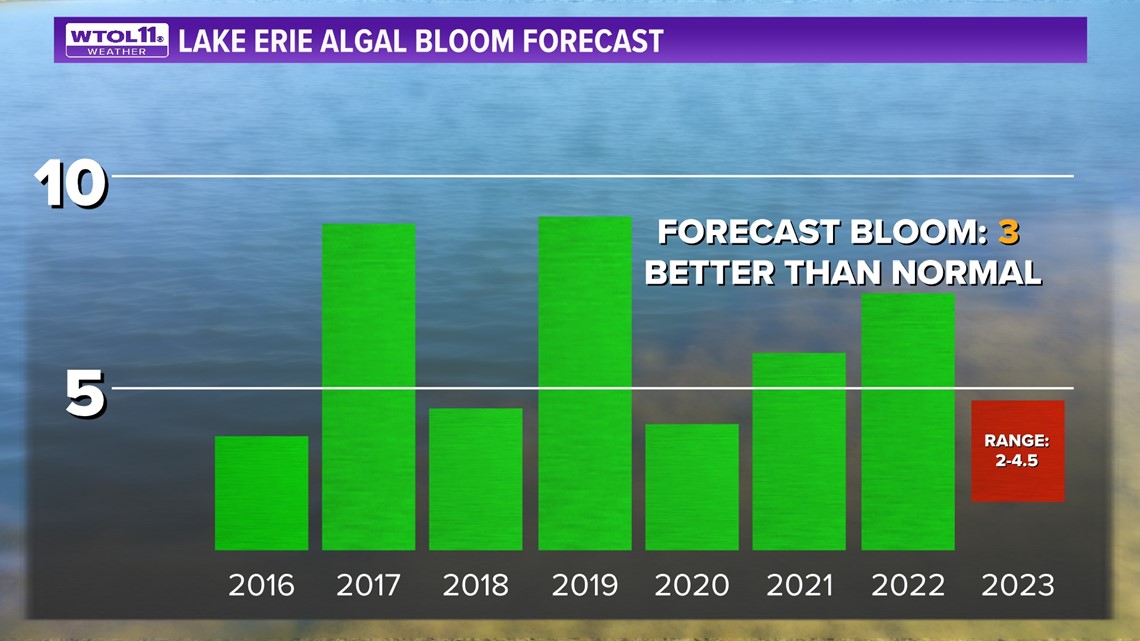PUT-IN-BAY, Ohio — Editor's note: The above video is from earlier coverage of Lake Erie harmful algal blooms that aired on March 21, 2023.
Scientists with the National Oceanic and Atmospheric Administration (NOAA) are forecasting a smaller-than-average harmful algal bloom (HAB) for western Lake Erie this summer, with a lower range estimate potentially smaller than any bloom the area has seen since 2007.
In a press release issued Thursday, NOAA officials said they estimate the bloom to land between 2 and 4.5 on the forecast bloom severity index, with the bloom most likely reaching 3 on the scale.
The index, which was developed in 2002, forecasts the bloom's severity based on its biomass, or the amount of algae, during the peak 30 days of the bloom, officials said. According to the index, a rating above 5 is a severe bloom, while anything above 7 is "particularly severe".
Bloom severity can have an impact on daily life and the local economy. HABs produce microcystin, a known liver toxin which can affect humans and wildlife. NOAA officials said the bloom forecasts help the public prepare for the health and economic impacts of HABs.
“As we move into the summer season, having accurate, reliable information about this year’s expected bloom will help protect public health and economic activity for communities along Lake Erie," NOAA Chief Scientist Sarah Kapnick said in a press release.
While the index does not have an upper limit, the largest blooms occurred in 2011 and 2015, with severity indices of 10 and 10.5, respectively. In 2022, the index was 6.8. Western Lake Erie has not seen a bloom index below 2 since 2007.


The smaller forecasted HAB was probably caused by the sustained dry conditions across northwest Ohio, NOAA scientists said. HABs, which consist of cyanobacteria, are fed by nutrient loads, mainly phosphorous used in fertilizer, that enter Lake Erie in the form of runoff after rainfall. Currently, much of northwest Ohio is "abnormally dry" or in a moderate drought, according to the U.S. Drought Monitor.
However, Lake Erie still received a significant nutrient load in March of this year, which will at least produce a mild bloom, scientists said. There is also the potential for additional rainfall and a subsequent nutrient load in July, which could lead to a larger bloom.
The size of an algal bloom, however, is not necessarily indicative of its toxicity, NOAA researchers explained. Toxins in a large bloom, for example, may be less concentrated than toxins in a smaller bloom. Each HAB is unique in size and toxicity.
The bloom, which typically concentrates in Lake Erie's western basin, usually begins to form in mid-to-late July. It dissipates in the autumn, but the timing is dependent on the frequency of wind events in September, according to the NOAA.
Harmful algal blooms affect northwest Ohio summers. The health risks posed by microcystin can cause cities to close beaches, preventing and limiting boating, fishing and swimming tourism. According to researchers, Lake Erie tourists spend more than $15 billion dollars annually, generating $1.9 billion in state taxes. It also supports over 100,000 tourism-related jobs.
HABs can even affect shoreline property values, analysts said. For every 1 μg/L (micrograms per liter) increase in harmful algae blooms in Lake Erie, homeowners near the lake can expect their property values to decrease by 1.7 percent, or $2,205.
NOAA officials stated research into algal blooms is ongoing and will help further predict and understand each year's HAB.
“This NOAA forecast and the research being conducted by academic institutions and both state and federal agencies to understand blooms and nutrient runoff will continue to guide efforts to address these summer bloom events," Christopher Winslow, director of Ohio Sea Grant and Stone Laboratory said.
RELATED VIDEO

